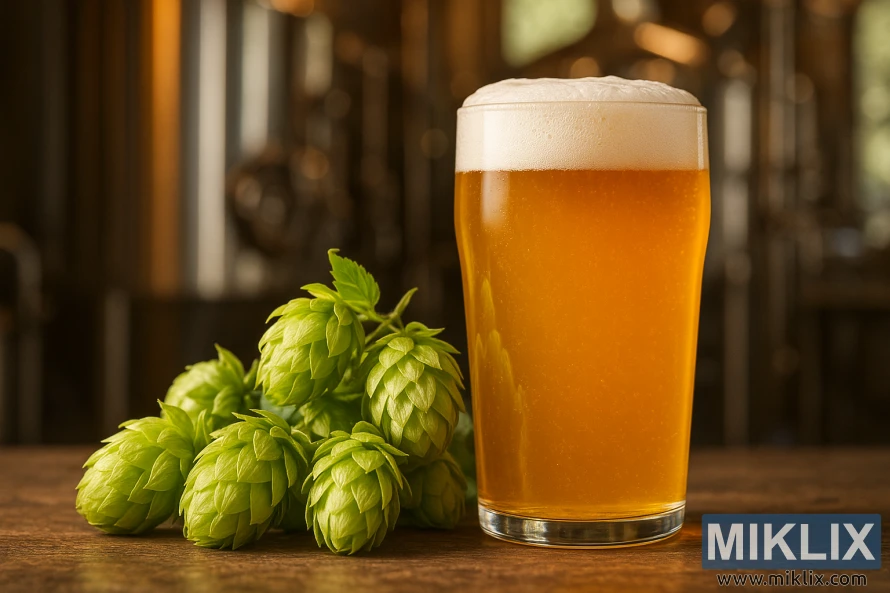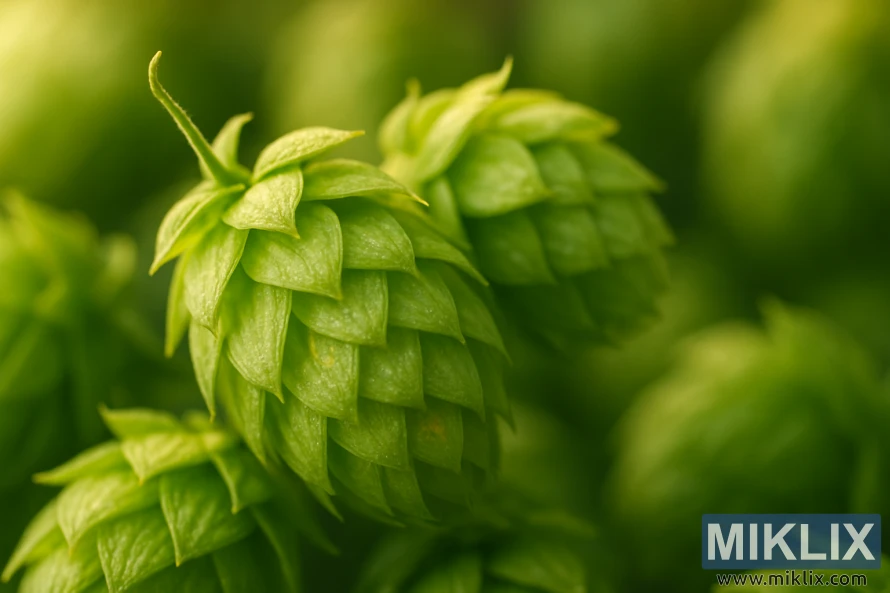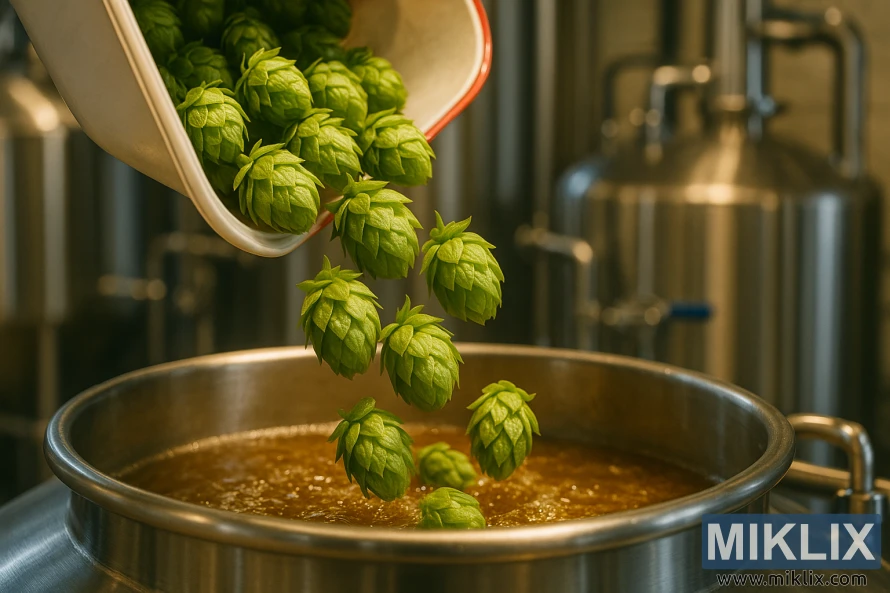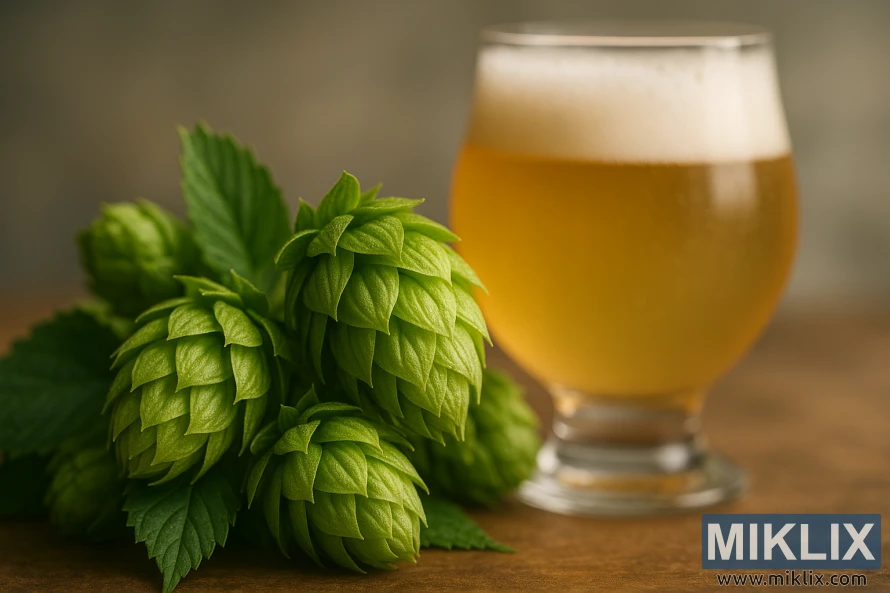Hops in Beer Brewing: Citra
Published: July 21, 2025 at 9:55:11 PM UTC
Beer brewing has seen a significant transformation with the advent of new hop varieties. Citra has emerged as a top choice among craft brewers. It boasts a strong yet smooth floral and citrus aroma and flavor. This dual-purpose hop is used in various stages of the brewing process. Citra's unique flavor profile makes it perfect for brewing IPA and other hoppy beers. This guide will dive into Citra's origin, brewing values, and pairing suggestions. It aims to help both novice and experienced brewers unlock its full flavor.

Key Takeaways
- Citra is a versatile hop variety used in multiple stages of beer brewing.
- It is known for its floral and citrus flavor profile.
- Ideal for brewing IPA and other hoppy beers.
- Can be used by both novice and experienced brewers.
- Enhances the aroma and flavor of beer.
What Are Citra Hops?
Developed by the Hop Breeding Company of Yakima, WA, Citra hops were first released in 2008. They quickly became a favorite among craft brewers for their unique flavor profile. This variety has become a staple in the brewing world.
Citra hops are celebrated for their vibrant citrus and tropical fruit notes. They are a versatile choice for many beer styles. The Hop Breeding Company aimed to create new hop varieties for brewers to craft complex and interesting beers.
The Hop Breeding Company's work involves crossing different hop varieties to achieve desired traits. Citra hops were the result of this effort. They are high in alpha acids and have a distinct aroma that is fruity and floral.
Introduced in 2008, Citra hops have been widely adopted in the brewing industry. They are used in a variety of beer styles, from IPAs to pale ales. Brewers value them for their ability to add depth and complexity to their creations.
The Distinctive Flavor Profile of Citra Hops
Citra hops are a favorite among craft brewers for their unique flavor profile. They offer a strong yet smooth floral and citrus aroma and taste. The aroma descriptors include grapefruit, citrus, peach, melon, lime, gooseberry, passion fruit, and lychee.
These diverse characteristics make Citra hops versatile for brewers. They can enhance a range of beer styles, from hoppy IPAs to crisp lagers. The distinct flavor profile of Citra hops is a major reason for their popularity.
The use of Citra hops in brewing has grown due to their ability to add complex and refreshing flavors. Whether for bittering, flavor, or aroma, Citra hops add a unique character to beer. This is highly valued by beer enthusiasts.
Understanding Citra hops' distinctive flavor profile opens up new possibilities in brewing. Brewers can create unique beers that highlight these exceptional hops' characteristics.
Essential Characteristics of Citra Hops
Citra hops stand out with their high alpha acid content and complex flavor profile. They have an alpha acid percentage ranging from 11% to 13%. This high percentage makes them ideal for adding robust bitterness to a variety of beers.
These hops are celebrated for their citrus, tropical fruit, and floral notes. They add depth and complexity to beers. In late hop additions, Citra hops bring a bright, citrusy flavor that enriches the beer's character.
The brewing values of Citra hops are diverse. They not only provide bitterness but also contribute to the beer's flavor and aroma. This versatility makes them a favorite among brewers, who use them in various brewing stages to achieve different effects.
Some key benefits of using Citra hops include:
- High alpha acid content for robust bitterness
- Complex flavor profile with citrus and tropical fruit notes
- Versatility in brewing applications, from bittering to late hop additions
- Compatibility with a range of beer styles, from IPAs to pale ales
When pairing hops, Citra can be combined with others to create unique flavors. Pairing Citra with Mosaic or Amarillo enhances the citrus character. Combining it with earthy hops like Chinook adds depth and balance.
In summary, Citra hops are a valuable ingredient in beer brewing. They offer a range of brewing values and pairing suggestions that enhance various beer styles. Their high alpha acid content, complex flavor profile, and versatility make them essential in many modern beer recipes.

Best Beer Styles for Citra Hops
Citra hops offer a unique flavor profile, making them perfect for various beer styles. From IPAs to pale ales, their citrus and floral notes enhance both flavor and aroma. This versatility has made them a favorite among brewers.
These hops are ideal for beers that highlight hoppy flavors without excessive bitterness. This characteristic makes them a go-to choice for brewers aiming for a balanced hop profile.
- India Pale Ale (IPA): Citra hops add a vibrant citrus flavor that complements the malty backbone of IPAs.
- Pale Ale: The floral and citrus notes of Citra hops enhance the refreshing quality of pale ales.
- Double IPA: Citra hops contribute to the complex hop flavor and aroma characteristic of double IPAs.
When brewing with Citra hops, achieving balance is key. Their potent flavor and aroma can overpower other ingredients if not used wisely.
Exploring different beer styles with Citra hops can lead to unique and exciting brews. Whether crafting a traditional IPA or something innovative, Citra hops add a compelling dimension to your beer.
Understanding Citra Hop Storage and Handling
Proper storage and handling of Citra hops are essential for preserving their flavor and aroma in beer brewing. Citra hops have a delicate flavor profile. This can be easily damaged if not stored or handled correctly.
To keep Citra hops in top condition, brewers should store them in a cool, dry place. This should be away from direct sunlight and heat sources. It's best to store Citra hops in airtight containers or vacuum-sealed bags. This prevents exposure to air, moisture, and light.
When handling Citra hops, brewers should aim to minimize exposure to air and heat. Using hop pellets or plugs instead of whole cones can help. This is because they are less prone to oxidation. Brewers should also handle Citra hops gently to avoid damaging them.
Some key tips for storing and handling Citra hops include:
- Store Citra hops in a refrigerator or freezer to slow down degradation.
- Use airtight containers or vacuum-sealed bags to prevent exposure to air and moisture.
- Handle Citra hops gently to prevent damage.
- Minimize exposure to heat, light, and air.
By following these tips, brewers can ensure their Citra hops retain their flavor and aroma. This results in high-quality beers that showcase the unique characteristics of Citra hops.
Brewing Techniques with Citra Hops
Citra hops offer brewers a chance to explore various brewing techniques. They can be used at different stages of brewing to craft unique flavor profiles. This versatility makes them a favorite among those who enjoy experimenting with beer.
Dry hopping is a popular method for using Citra hops. It involves adding hops to the beer after fermentation. This allows the hops to add their flavors and aromas without increasing bitterness.
- Early boil additions for bitterness
- Late boil additions for flavor and aroma
- Dry hopping for enhanced aroma
- Hop bursting for intense flavor
Each technique can produce different effects in the beer. For instance, early boil additions can add a unique bitterness. Late boil additions, on the other hand, can boost the beer's flavor and aroma.
Dry hopping with Citra hops is known for its ability to add vibrant, fruity aromas. This method is often combined with other hops to create complex flavors.
When brewing with Citra hops, consider a few key points:
- Use the right amount of hops for the desired flavor and aroma.
- Time hop additions correctly to maximize their impact.
- Store hops properly to keep their potency.
By mastering these techniques and understanding Citra hops, brewers can create a wide variety of beers. These beers showcase the unique qualities of this versatile hop variety.

Dry Hopping Methods for Citra
The art of dry hopping with Citra hops demands precision and a deep understanding of brewing. Dry hopping enhances beer's aroma without adding bitterness. Citra hops, known for their intense citrus and floral flavors, are a top choice.
To maximize Citra hops in dry hopping, timing and quantity are key. Brewers typically add Citra hops late in fermentation or after it's complete. The amount can vary, but usually ranges from 1-5 grams per liter. This depends on the desired flavor and aroma intensity.
There are several methods for dry hopping with Citra hops. One common approach is adding hops directly to the fermentation tank or a separate vessel. Another method uses a hop bag or diffusion device. This helps release the hops' oils and flavor compounds into the beer.
- Use a sufficient quantity of Citra hops to achieve the desired flavor profile.
- Monitor the dry hopping time to avoid over-hopping, which can lead to vegetal or grassy flavors.
- Consider the storage conditions of the hops before use to preserve their potency.
By mastering dry hopping techniques with Citra hops, brewers can craft complex, aromatic beers. These beers highlight the unique characteristics of these hops.
Common Mistakes When Using Citra Hops
Citra hops bring incredible flavor and aroma to beer, but brewers must be cautious. Their intense citrus and tropical fruit notes are a favorite among craft brewers. Yet, their potency can lead to an unbalanced flavor if not used correctly.
One common error is over-hopping. Too many Citra hops can make a beer taste overly bitter or have an unbalanced aroma. Brewers should measure their hop additions carefully and consider the desired hop profile.
Another mistake is not considering the timing of hop additions. Citra hops can be used for both bittering and aroma. The timing of their addition significantly affects the final flavor. For bitterness, they should be added early in the boil. For aroma, they are best added late in the boil or during dry hopping.
- Measure hop additions carefully to avoid over-hopping.
- Consider the timing of hop additions for the desired effect.
- Store Citra hops properly to preserve their flavor and aroma.
By avoiding these common mistakes, brewers can unlock the full flavor of Citra hops. This way, they can create exceptional beers.
Pairing Citra Hops with Other Varieties
Citra hops are incredibly versatile, making them perfect for blending with other hop varieties. This combination allows brewers to craft beers with complex, unique flavors. It enhances the overall character of the brew.
Pairing Citra hops with others can balance and refine the flavor. For instance, they can be mixed with bitter hops to counterbalance their citrus and tropical fruit notes. Or, they can be paired with aroma hops to boost the beer's aroma.
Popular pairing options include Simcoe, Amarillo, and Mosaic hops. These hops share similarities with Citra in their citrus and pine notes but add distinct qualities. By experimenting with different combinations, brewers can create beers that truly stand out.
When blending Citra hops with others, consider the flavor profile you aim to achieve. Begin with small batches and adjust the hop ratios as needed. This method helps fine-tune the flavor, ensuring the final product meets your expectations.
Commercial Beer Examples Using Citra
Citra hops have revolutionized commercial beer production, creating complex and refreshing brews. They've become essential in many breweries, mainly for IPAs and pale ales.
Renowned breweries like Stone Brewing and Sierra Nevada have successfully integrated Citra hops into their beers. This has resulted in unique, complex flavor profiles. Their hop-forward IPAs have received widespread acclaim.
- Pliny the Elder by Russian River Brewing Company
- Heady Topper by The Alchemist
- Hop Hunter by Firestone Walker
Using Citra hops in commercial beer production offers numerous benefits. They bring a unique flavor profile, combining citrusy and floral notes. This versatility makes them a favorite among brewers. Their high alpha acid content also makes them perfect for hop-forward beers.
The impact of Citra hops on commercial beer production is significant. They've led to a variety of innovative, delicious beers. As the craft beer industry grows, Citra hops will likely remain a top choice for brewers.
Measuring and Timing Citra Hop Additions
Accurate measurement and timing of Citra hop additions are key to unlocking their full flavor. Citra hops offer a complex flavor profile, including citrus, tropical fruit, and stone fruit notes. Brewers must carefully measure and time their Citra hop additions to achieve the desired flavor.
Measuring Citra hops involves determining the right amount to add to the brew. The amount needed depends on the beer style, desired hop intensity, and alpha acid content. Brewers use a hop scale or measuring cups for accurate measurements.
Timing is also critical for Citra hop additions. The timing varies based on the brewing technique. For example, bittering hops are added early in the boil, while flavor and aroma hops are added later. Citra hops can be used for both, with timing depending on the desired hop intensity.
- For bittering additions, Citra hops can be added at the beginning of the boil.
- For flavor additions, Citra hops can be added 15-20 minutes before the end of the boil.
- For aroma additions, Citra hops can be added during the last 5 minutes of the boil or during dry hopping.
By carefully measuring and timing Citra hop additions, brewers can achieve the desired flavor profile. This results in a balanced and complex beer. Whether brewing a hoppy IPA or a subtle pale ale, Citra hops add depth and complexity.
Maximizing Citra Hop Aroma
To fully appreciate Citra hops, brewers must grasp how to enhance their aromatic qualities. These hops are celebrated for their lively citrus and tropical fruit scents. The right brewing methods can preserve and boost these aromas.
Citra hops are famous for their intense citrus and tropical fruit aromas. To maximize these, brewers employ techniques like dry hopping. This involves adding Citra hops late in fermentation or after it's complete.
Dry hopping with Citra hops significantly boosts a beer's aroma. Here are some strategies for dry hopping:
- Use a sufficient quantity of Citra hops. The amount can vary depending on the beer style and desired intensity of aroma.
- Choose the right time for dry hopping. Adding Citra hops too early can result in the loss of some of their delicate aromas.
- Consider the temperature and environment. Dry hopping at cooler temperatures can help preserve the aroma compounds.
Maximizing Citra hop aroma can elevate a beer's character, making it more complex and appealing. Beers with pronounced Citra hop aroma are often described as vibrant and refreshing.
By applying these techniques and understanding the benefits, brewers can create beers that showcase the unique aroma of Citra hops.

Troubleshooting Citra-Hopped Beers
Mastering Citra-hopped beers requires a deep dive into how these hops interact with other brewing components. Known for their vibrant flavor and aroma, Citra hops can be tricky to balance perfectly.
One frequent challenge brewers face is over-hopping. This happens when too many hops are used, leading to an overly bitter or unbalanced taste. To sidestep this, brewers must accurately measure hop additions and consider the wort's specific gravity.
Another issue is the loss of aroma during fermentation. Citra hops are susceptible to losing their delicate aroma if not managed correctly. To reduce this loss, brewers can employ dry hopping. This involves adding hops during or after fermentation to keep the aroma intact.
Flavor imbalances are another common problem. Citra hops have a distinct taste that can be easily overshadowed by other ingredients. Achieving a balanced flavor requires careful consideration of the malt bill and yeast strain used.
- Monitor hop addition rates to avoid over-hopping.
- Use dry hopping techniques to preserve Citra hop aroma.
- Balance Citra hop flavor with complementary malt and yeast profiles.
By grasping these common issues and applying effective troubleshooting methods, brewers can fully harness the power of Citra hops. Whether crafting an IPA or a pale ale, Citra hops can introduce a unique and captivating element to your brew.
Recipe Development with Citra Hops
Brewers can explore a vast range of flavors by using Citra hops in their recipes. These hops are celebrated for their unique taste and aroma. They are a great choice for many beer styles.
When crafting recipes with Citra hops, brewers should think about the flavors they aim to highlight. Citra hops bring citrus and tropical fruit notes. These can enrich and deepen beer flavors.
Here are some tips for brewers looking to experiment with Citra hops in their recipe development:
- Start by substituting Citra hops into existing recipes to understand how they impact the flavor profile.
- Experiment with different hop addition times to achieve the desired balance of bitterness, flavor, and aroma.
- Consider pairing Citra hops with other hop varieties to create unique and complex flavor profiles.
IPAs, pale ales, and sour beers are among the styles that benefit from Citra hops. Adding Citra hops to these styles can result in beers with vibrant, citrusy notes.
To fully exploit Citra hops, brewers must also consider storage, handling, and timing. Proper care can preserve the delicate oils and flavors found in Citra hops.
Conclusion
Citra hops have transformed the beer brewing world with their distinct flavor and versatility. This article has explored how Citra hops can enhance a range of beer styles, from IPAs to pale ales.
Understanding Citra hops' characteristics and using effective brewing methods can unlock their full benefits. Whether you're an experienced brewer or new to the craft, Citra hops open up a world of creative possibilities.
In summary, Citra hops are a must-have for brewers. Their unique flavor and aroma can take a beer to new levels. By following the advice in this article, brewers can create exceptional beers that highlight Citra hops' unique qualities.
Further Reading
If you enjoyed this post, you may also like these suggestions:
